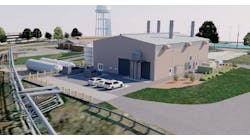The fuel cell market, pegged at $1.3 billion worldwide, appears to be riding up with the grid resiliency effort in the U.S.
A new report, “The Business Case for Fuel Cells 2014: Powering the Bottom Line for Businesses and Communities,” cites growing interest in fuel cells among Fortune 500 companies, utilities and municipalities.
Several microgrid projects are underway that employ fuel cells. Those noted in the report include two planned in Connecticut, both funded through the state’s grid resiliency effort, born out of storms that caused widespread and prolonged power outages.
- Woodbridge municipal microgrid, which will employ a 400-kW fuel cell to help power police and fire stations, municipal buildings and a high school during natural disasters.
- The University of Connecticut Depot Campus Microgrid, which will use a 400-kW fuel cell at its Storrs facility.
The report also mentions a 2.6-MW fuel cell installed as part of the University of California, San Diego’s microgrid, which generates eight percent of the campus’ energy needs.
Citing White House statistics, the report said that weather-related power failures cost the economy $18-$33 billion annually between 2003 and 2012. A 2012 Congressional Research Service study puts the number higher, at $25-$70 billion, the report said.
“Fuel cells have proved themselves through several recent storms, providing reliable primary power and emergency backup power to customers ensuring seamless communications and services when the electric grid was vulnerable or out of commission,” the report said.
Two years ago ‘the city that never sleeps at night’ ended up in a near coma because of Superstorm Sandy. Learn how NYC and other parts of North America are trying to ensure that never happens again.
Fuel cells still remain largely a niche technology because of their costs. But the report, now in its fifth year, notes that good financing, such as power purchase agreements, can change the cost proposition.
“The answer isn’t that simple, as many installations aren’t direct off-the-shelf purchases, instead using innovative financing mechanisms and state and federal tax incentives to fund them,” the report said.
Fuel cells are also eligible for the federal Investment Tax Credit which provides a 30 percent tax credit up to $3,000/kW on a fuel cell system installed before 2017. The ITC is scheduled to expire at the end of 2016. Combined heat and power systems, which sometimes use fuel cells, also are eligible for a 10 percent tax credit.
Some states also offer incentives, most notably California, where the Self-Generation Incentive Program provides $1.83/watt for CHP or electric-only fuel cells.
Yahoo!, DreamWorks, and SoftBank are among new fuel cell customers noted in the report. In addition, the report highlighted repeat customers, among them since last year:
- Walmart, AT&T and Verizon have furthered their commitment to fuel cell technology, with more than 30 MW of stationary fuel cells collectively installed or on order at sites in California, Connecticut, New Jersey and New York.
- Walmart has ordered more than 2,000 fuel cells for material handling vehicles at seven sites, boosting its fleet to more than 2,500 fuel cell-powered forklifts at 10 sites in North America.
Other returning customers include retailers Kroger, Central Grocers, and Ace Hardware, the report said.
Delmarva Power, Dominion, NRG Energy, and WGL Holdings are among electric utilities and generation companies that now use use multi-megawatt fuel cells. In addition, Exelon and NRG Energy are offering fuel cells as a distributed energy option to customers.
California, Connecticut, Hawaii, New York, Ohio and South Carolina are among adding fuel cells to municipal or transit facilities to help meet greenhouse gas reduction goals, improve reliability, and save taxpayer dollars, the report added.
Written by the Breakthrough Technologies Institute, the report is available for free download here.
“Fuel cells are proving to be a sound investment in efficiency, reliability and sustainable energy production. Businesses and governments report that fuel cells also benefit the bottom line,” said Robert Rose, BTI’s executive director. “The business case for fuel cells gets stronger every year.”
Separate from the report, FuelCell Energy also has been reporting new orders, most recently the sale of six fuel cell modules totaling 8.4 MW to its South Korean partner POSCO. The fuel cell manufacturer is expanding its 65,000 square foot Torrington, Conn. manufacturing facility by 90,000 square feet for a total size of 155,000 square feet.
“We will increase our production levels as demand warrants and are positioning ourselves for the growth that we expect based on business activity arising from the growing need for the ultra-clean on-site power solutions we provide,” said Chip Bottone, FuelCell Energy CEO.






